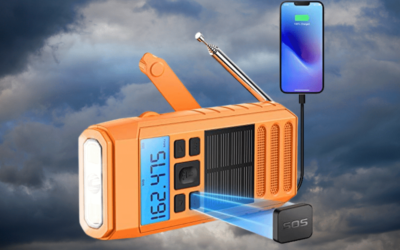Have you ever lost your furry best friend? We’ve all been there, stuck in panic mode until they finally appear at the door. But what if you could avoid that moment of fear and keep track of your pup at all times? With the right GPS tracker, you can do just that! Here’s our guide to help you find the best GPS tracker for dogs.
GPS tracking technology has revolutionized the way we keep an eye on our pets. With a GPS tracker, you can find out precisely where your dog is and where she’s been. What’s more, GPS trackers help make getting your dog back a whole lot easier if they ever get lost. We’ve researched the market to find the best GPS tracker for dogs so that you can make sure that your pooch is always safe and sound.
Top 3 GPS Trackers for Dogs in 2025
- REAL-TIME GPS TRACKING WITH UNLIMITED RANGE: Track your dog’s live location nationwide with updates every 2-3 seconds—up to 30x faster than competitors who only update once per minute. Perfect for keeping an eye on your dog no matter where they roam.
- 【No Monthly Fee, Pet Finder】— The GPS tracker for dog is free of any service fee or monthly fee. Pet tracker with holder is a pet finder that can continuously monitor in real time, so that you can accurately know the location and moving direction of your pet, keep an eye on its whereabouts at any time, and avoid your pet from being lost or stolen.
Benefits of GPS Trackers for Dogs
GPS trackers for dogs provide valuable benefits to pet owners, such as the ability to quickly and easily locate your pet at all times. This peace of mind can be especially useful in rural areas with large stretches of land or in cities with high traffic and busy streets. GPS trackers are also an important tool for keeping lost or stolen pets safe and secure.
In addition to providing location information, many GPS dog trackers also offer other useful features such as activity tracking, real-time notifications, temperature monitoring, and remote control capabilities. This can be instrumental in helping pet owners understand their dog’s behavior and habits, ensuring that they remain healthy and safe.
GPS dog tracking systems can also alert you if your dog has left a designated safe zone so that you know there is a potential problem. If a pet is lost or stolen, the tracker can provide invaluable assistance in locating them quickly before they get too far away. Finally, another key feature of many GPS systems is the ability to monitor a pet’s daily activities both indoors and outdoors so that owners can ensure their furry friends are getting enough exercise and staying active throughout the day.
Types of GPS Trackers
GPS dog trackers use satellite technology to pinpoint the exact location of your pet. They come in a variety of styles and sizes, including wearable collars, handheld devices, and monitoring systems. While each type offers a slightly different set of features, all are designed to keep your pet safe and help you locate them if they’re ever lost or run away.
Wearable Collar Trackers: These GPS-enabled collars have built-in sensors that detect the location of your pet. Many trackers provide real-time updates on where your pet is located, while others send an alert when they move outside a pre-defined boundary. Some collars also include additional features like temperature monitoring or pet activity recording.
Handheld Trackers: This type of device is held in the hand and typically includes an antenna that receives a signal from satellites orbiting Earth. It helps users track down their pets quickly by showing its exact location on a map or providing directions to find it. Handheld devices are often best for those who want to keep tabs on their pet’s whereabouts at all times as they are easy to carry with you wherever you go.
Monitoring Systems: These systems use multiple sensors that can be placed around the home or outdoors (to cover larger areas). The sensors detect your pet’s location in real time and can even be setup to provide alerts if it leaves the designated area so you can always check up on them from anywhere if need be. This type is well-suited for those who need comprehensive tracking without having to carry extra devices around with them..
Features to Consider When Buying a GPS Tracker
When it comes to buying a GPS tracker for your pet, there are several factors you should consider. Here are some of the main features that can help you find the ideal device for your pup:
Battery Life: Battery life is one of the most important aspects to consider, as you don’t want the device to run out of power in the middle of a tracking session. Look for GPS trackers with extended battery life that can last up to several days or even weeks on a single charge.
Real-time Tracking: Real-time tracking is essential for keeping an eye on your pet’s whereabouts and activities. Many modern trackers come with this useful feature and can stream real-time location data right onto your phone or computer.
Versatility: A versatile GPS tracker is key if you plan on taking your pup along with you on long trips or hikes. Look for durable, waterproof models that are designed to withstand extreme weather conditions and terrain.
Connectivity: The best GPS trackers use cellular technology as well as Bluetooth connectivity which enable them to sync with multiple devices at once and provide more accurate location data. Check what type of network coverage the device supports in order to ensure full coverage at all times.
Alerts & Notifications: Alerts and notifications can give you an insight into your pet’s activities, such as whether they have entered a certain area or gone beyond designated boundaries. Some devices also come with additional features such as temperature sensors which can help you monitor your pup’s environment while they’re outdoors.
Popular GPS Trackers for Dogs
The first step in choosing the right GPS tracker for your pet is to understand which type would best meet your needs. Various GPS trackers are available on the market, and they employ different types of technology.
Popular GPS Trackers for Dogs
Global Positioning System (GPS) trackers are ideal devices for locating a canine companion. They are readily available in various sizes and styles, so it’s important to evaluate your tracking needs when selecting a tracker. Popular models include:
-Android-Compatible Trackers: Android-compatible trackers usually come as an app on your phone or tablet that uses cellular towers or Wi-Fi signals to detect the location of an object or person equipped with a similar GPS device or chip.
-Radio Frequency (RF) Trackers: RF trackers provide up to a quarter mile range and use radio signals between the transmitter and receiver(s). RF systems generally require an annual subscription but can yield potentially higher accuracy than standalone systems.
-Standalone GPS Tracking Devices: Standalone GPS tracking devices provide remote tracking—in some cases over thousands of miles away from the device’s signal strength limitations—and require no monthly service fees. They typically come with SOS buttons in case of emergency, geo-fencing technology, sensory triggers, speed monitoring limits, and other tracking capabilities depending on the model chosen.
Selecting the right option depends upon factors such as cost, precision, range requirements, and user convenience level. It is likely that features such as temperature regulation or exercise monitoring will be needed as well; each model varies in these attributes so be sure to choose one that fulfills all expectations before making a purchase!
Installation and Setup
Installing and setting up a GPS tracker for your dog is a relatively simple process that can provide you with peace of mind when it comes to knowing your pet’s whereabouts. Depending on the type of tracker that you purchase, installation may require mounting the device on your pet’s collar or implanting a chip under their skin. Once installed, simply download the app and sync it with the tracker to start tracking your pup!
The main components of setting up & installing a GPS tracker for dogs are:
-Choosing the right GPS tracker (size, features, battery life etc.)
-Mounting/installing: Depending on the type of tracker that you buy, mounting or implanting may be required. Make sure you read instructions carefully and utilize all safety protocols.
-Syncing Tracker & App: Download the app from either iTunes or Google Play Store and sync it with your tracking device
-Testing Tracker & Establishing Boundaries: Test out distance range from home or other predetermined spots such as parks and trails to ensure appropriate boundaries are set
-Post Installation: Make regular checks for optimal performance and ensure that batteries are changed at regular intervals
Maintenance and Troubleshooting
Once you’ve selected the right GPS tracker and installed it on your pet’s collar, it is important to maintain the device and troubleshoot any problems that may arise. The following tips can help you ensure a trouble-free experience with your pet’s device:
Regularly Check Batteries and Connection Strength: Make sure to check the battery life of the GPS tracker regularly, as well as its connection strength. Most trackers have an app or a website that show connection status at a glance. Weak connections can affect accuracy, so if needed switch to a stronger network to maintain real-time tracking of your pet.
Review settings for Accuracy: All GPS trackers come with settings that you can adjust for optimal accuracy. Many components can influence tracking accuracy including terrain, signal obstructions (such as tall trees or buildings) and distance from base stations. Review all these settings after installation and make adjustments as necessary.
Check Data Quality Regularly: Regularly review data quality on your chosen tracker platform; this includes motion data, sleeping patterns and other health indicators, etc., which provides further insight into your pet’s habits over time. Data given should be compared to other sources such as vet records over time to find trends or discrepancies in behaviour or health indicators for further investigation
Update Firmware When Necessary: Most GPS trackers rely on firmware updates to maintain their performance quality over time; check with the manufacturer of your pet’s device intermittently for available updates, download them if required and follow instructions carefully when upgrading firmware versions.
Conclusion
Finding the best GPS tracker for your furry family members doesn’t have to be a daunting task. With the variety of trackers on the market and reviews from other pet parents, you should be able to find one that will suit your needs and keep your dog safe. Just remember that it is important to make sure the device you choose is reliable, ultra-durable and easily rechargeable. Many metal-bodied tracking collars are water-resistant or even waterproof so that they don’t get ruined if your pup jumps in a puddle or spends lots of time in a wet climate. Finally, think about how often you’ll need/want to check up on your pup as you decide which type of device best fits your lifestyle to ensure they get the safety they deserve!




